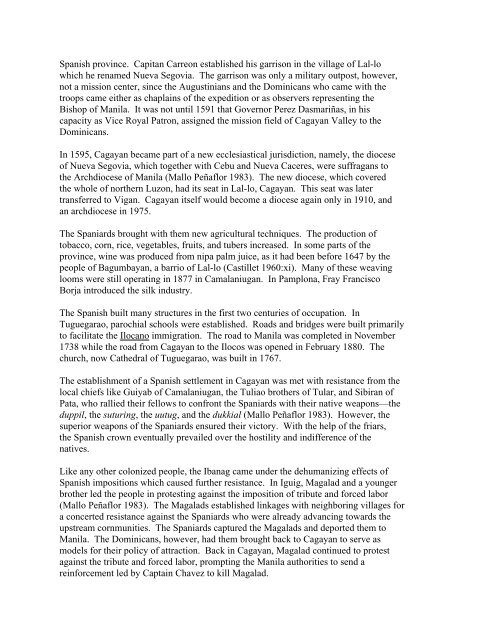The word “Ibanag” derives from the prefix “i” meaning ... - Buffalo
The word “Ibanag” derives from the prefix “i” meaning ... - Buffalo
The word “Ibanag” derives from the prefix “i” meaning ... - Buffalo
Create successful ePaper yourself
Turn your PDF publications into a flip-book with our unique Google optimized e-Paper software.
Spanish province. Capitan Carreon established his garrison in <strong>the</strong> village of Lal-lo<br />
which he renamed Nueva Segovia. <strong>The</strong> garrison was only a military outpost, however,<br />
not a mission center, since <strong>the</strong> Augustinians and <strong>the</strong> Dominicans who came with <strong>the</strong><br />
troops came ei<strong>the</strong>r as chaplains of <strong>the</strong> expedition or as observers representing <strong>the</strong><br />
Bishop of Manila. It was not until 1591 that Governor Perez Dasmariñas, in his<br />
capacity as Vice Royal Patron, assigned <strong>the</strong> mission field of Cagayan Valley to <strong>the</strong><br />
Dominicans.<br />
In 1595, Cagayan became part of a new ecclesiastical jurisdiction, namely, <strong>the</strong> diocese<br />
of Nueva Segovia, which toge<strong>the</strong>r with Cebu and Nueva Caceres, were suffragans to<br />
<strong>the</strong> Archdiocese of Manila (Mallo Peñaflor 1983). <strong>The</strong> new diocese, which covered<br />
<strong>the</strong> whole of nor<strong>the</strong>rn Luzon, had its seat in Lal-lo, Cagayan. This seat was later<br />
transferred to Vigan. Cagayan itself would become a diocese again only in 1910, and<br />
an archdiocese in 1975.<br />
<strong>The</strong> Spaniards brought with <strong>the</strong>m new agricultural techniques. <strong>The</strong> production of<br />
tobacco, corn, rice, vegetables, fruits, and tubers increased. In some parts of <strong>the</strong><br />
province, wine was produced <strong>from</strong> nipa palm juice, as it had been before 1647 by <strong>the</strong><br />
people of Bagumbayan, a barrio of Lal-lo (Castillet 1960:xi). Many of <strong>the</strong>se weaving<br />
looms were still operating in 1877 in Camalaniugan. In Pamplona, Fray Francisco<br />
Borja introduced <strong>the</strong> silk industry.<br />
<strong>The</strong> Spanish built many structures in <strong>the</strong> first two centuries of occupation. In<br />
Tuguegarao, parochial schools were established. Roads and bridges were built primarily<br />
to facilitate <strong>the</strong> Ilocano immigration. <strong>The</strong> road to Manila was completed in November<br />
1738 while <strong>the</strong> road <strong>from</strong> Cagayan to <strong>the</strong> Ilocos was opened in February 1880. <strong>The</strong><br />
church, now Ca<strong>the</strong>dral of Tuguegarao, was built in 1767.<br />
<strong>The</strong> establishment of a Spanish settlement in Cagayan was met with resistance <strong>from</strong> <strong>the</strong><br />
local chiefs like Guiyab of Camalaniugan, <strong>the</strong> Tuliao bro<strong>the</strong>rs of Tular, and Sibiran of<br />
Pata, who rallied <strong>the</strong>ir fellows to confront <strong>the</strong> Spaniards with <strong>the</strong>ir native weapons—<strong>the</strong><br />
duppil, <strong>the</strong> suturing, <strong>the</strong> uutug, and <strong>the</strong> dukkial (Mallo Peñaflor 1983). However, <strong>the</strong><br />
superior weapons of <strong>the</strong> Spaniards ensured <strong>the</strong>ir victory. With <strong>the</strong> help of <strong>the</strong> friars,<br />
<strong>the</strong> Spanish crown eventually prevailed over <strong>the</strong> hostility and indifference of <strong>the</strong><br />
natives.<br />
Like any o<strong>the</strong>r colonized people, <strong>the</strong> Ibanag came under <strong>the</strong> dehumanizing effects of<br />
Spanish impositions which caused fur<strong>the</strong>r resistance. In Iguig, Magalad and a younger<br />
bro<strong>the</strong>r led <strong>the</strong> people in protesting against <strong>the</strong> imposition of tribute and forced labor<br />
(Mallo Peñaflor 1983). <strong>The</strong> Magalads established linkages with neighboring villages for<br />
a concerted resistance against <strong>the</strong> Spaniards who were already advancing towards <strong>the</strong><br />
upstream cornmunities. <strong>The</strong> Spaniards captured <strong>the</strong> Magalads and deported <strong>the</strong>m to<br />
Manila. <strong>The</strong> Dominicans, however, had <strong>the</strong>m brought back to Cagayan to serve as<br />
models for <strong>the</strong>ir policy of attraction. Back in Cagayan, Magalad continued to protest<br />
against <strong>the</strong> tribute and forced labor, prompting <strong>the</strong> Manila authorities to send a<br />
reinforcement led by Captain Chavez to kill Magalad.
















